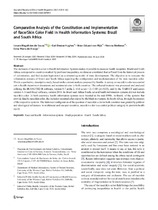Comparative analysis of the constitution and implementation of race/skin color field in health information systems: Brazil and South Africa
Abstract
The inclusion of race/skin color in Health Information Systems makes it possible to measure health inequities. Brazil and South Africa correspond to countries marked by profound inequalities, multiracial constituted that suffered from the historical process of colonization, and had racism legitimized as a structuring model of state development. The objective is to compare the information systems of Brazil and South Africa regarding the configuration and implementation of the item race/skin color. This is a qualitative, descriptive study, based on the content analysis proposed by Bardin. A survey on race/skin color was carried out in health department documents and ministerial sites in both countries. The collected material was processed and analyzed utilizing the IRAMUTEQ R software, version 0.7 alpha 2, with a test × 2 > 3.80 (p < 0.05), and by the TABNET application version 4.14 and Excel software, version 2016. In Brazil and Africa South, several health information systems did not include race/skin color. In both countries, health information systems were boosted in the mid-1990s. In Brazil, of the systems that provide data by race/skin color, the inclusion occurred after claims by the black movement. In South Africa, through the creation of the respective systems. The historical configuration of the question of race/skin color in both countries was guided by political and ideological references. In multiracial and unequal countries, race/skin color is a central political category to promote health equity.

